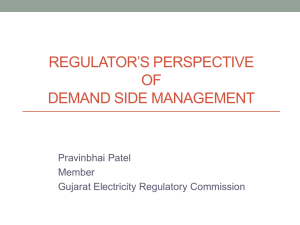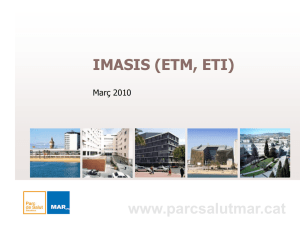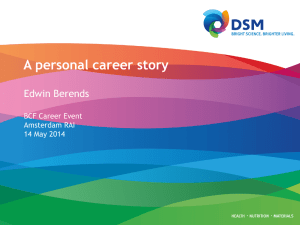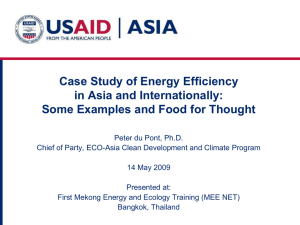Chapter 5 - Performance Index
advertisement
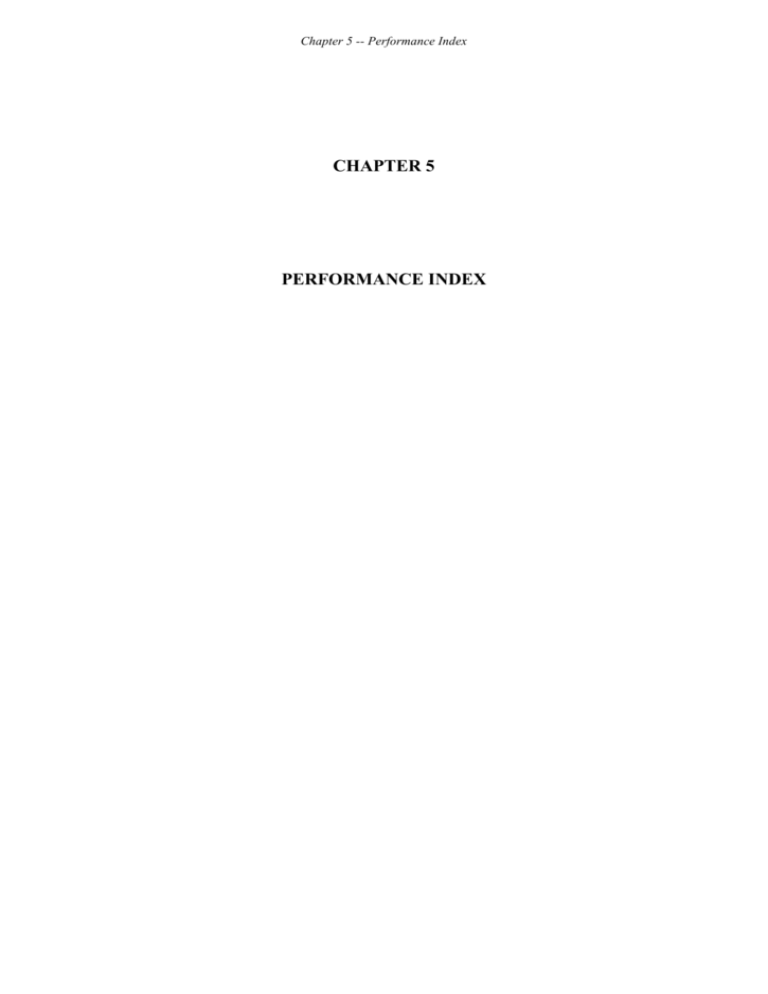
Chapter 5 -- Performance Index
CHAPTER 5
PERFORMANCE INDEX
Chapter 5 -- Performance Index
1.
PERFORMANCE INDEX CALCULATIONS
1.1
PERFORMANCE INDEX CONCEPT
The DSM Performance Index concept is defined as follows:
DSM Performance Index =
energy related capacity savings +reliability related capacity savings
where:
energy related capacity savings = the portion of avoided supply side investment attributed
to energy production; and
reliability related capacity savings = the portion of avoided supply side investment
attributed to system reliability.
1.2
GENERAL EQUATIONS FOR CALCULATION OF PERFORMANCE
INDEX
The Performance Index in each year based on the annual energy savings (kWh/yr) and
capacity savings (kW/yr) achieved by all DSM measures installed under various programmes
shall be calculated according to the following formula:
Annual DSM Performance Index (HK$) = (ES x CAPer) + (CS x CAPrel)
Page 5-1
Chapter 5 -- Performance Index
where :
ES
=
annual energy savings (kWh/yr) at generator level for all DSM
measures;
CAPer
=
energy-related capital (expressed in $/kWh based on assumed capacity
factor). This is defined as the difference in capital cost ($/kW)
between a base load unit and a peaking unit divided by the expected
average annual operating hours;
CS
=
annual capacity savings (kW/yr) at generator level of all DSM
measures;
CAPrel
=
reliability-related capital ($/kW). This is defined as the capital cost of
peaking unit and transmission and distribution facilities adjusted to
reflect the associated losses and system reserve capacity status.
For a 3-year DSM Resource Plan, the DSM measures installed under various programmes
implemented in each programme year will have impacts on the power system throughout the
lifetimes of the installed measures. The annual energy and capacity savings achieved by the
respective measures are assumed to persist throughout their lifetimes. Therefore the total
DSM Performance Index for a 3-Year DSM Resource Plan is equal to the sum of annual
DSM Performance Indexes, which are calculated based on the total annual energy and
capacity savings achieved by all installed measures during their lifetimes, i.e.
Total DSM Performance Index for a 3-year DSM Resource Plan
n
=
(Annual DSM Performance Index)j
j=1
n
=
(ESj x CAPer) + (CSj x CAPrelj)
j=1
where n is the time horizon over which the DSM measures installed within the 3-year DSM
Resource Plan period under various programmes have impacts on the power system (i.e.,
assume the lifetime of a commercial HVAC unit is 16 years. If such measures were installed
Page 5-2
Chapter 5 -- Performance Index
in programme years 1 to 3 under a commercial HVAC programme, then the time horizon, i.e.
n, that these measures will have impacts on the system is 18 years).
1.3
DETAILED PERFORMANCE INDEX CALCULATIONS
The performance index equation in expanded form factoring the Hong Kong situation is
provided below:
Annual DSM Performance Index (HK$) =
{ES’j x (CAPCOAL -CAPGT) / ((8760 x CF) x (1-LTRANS) x (1-LWORK))} +
{ CAPGT x CS’j x (1+RM) / ((1-LTRANS) x (1-LWORK)) + (CAPT&D x CS’j) / (1-LTRANS)}
therefore.
Total DSM Performance Index (HK$) for a 3-year DSM Resource Plan =
n
{ES’j x (CAPCOAL -CAPGT)/((8760 x CF) x (1-LTRANS) x (1-LWORK))} +
j=1
{ CAPGT x CS’j x (1+RM) / ((1-LTRANS) x (1-LWORK)) + (CAPT&D x CS’j) / (1-LTRANS)}
Where,
n
= the time horizon when DSM measures installed within the 3-year DSM
Resource Plan period have impacts on the power system
ES’j
= annual energy savings (kWh/yr) at consumer level of all DSM measures
installed under respective programmes in year j
LWORK
= works losses (constant for the first Resource Plan)
LTRANS
= T&D losses (constant for the first Resource Plan)
CAPCOAL = avoided cost of the coal plant ($/kW) (constant for the first Resource Plan)
CAPGT
= avoided cost of a peaking unit ($/kW) (constant for the first Resource Plan)
CF
= capacity factor (constant for the first Resource Plan)
RM
= optimal reserve margin (constant for the first Resource Plan)
CAPT&D = avoided cost of the T&D facilities ($/kW) (constant for the first Resource Plan)
CS’j
= annual capacity savings (kW/yr) at customer level of all DSM measures
installed under respective programmes in year j
Page 5-3
Chapter 5 -- Performance Index
The agreed values of the above key parameters, which are assumed constant for the first DSM
Resource Plan, are shown in Appendix I.
2.
COST-EFFECTIVENESS ASSESSMENT AND AUDIT PROCEDURES
2.1
AUDIT REQUIREMENTS
2.1.1
During and After Year 1
During or immediately after Year 1, DSM programme cost effectiveness may be evaluated for
planning purposes but is not mandatory. However, a sampling of participants (the exact
number to be determined by the Utility to satisfy its programme control requirements) will
need to be site-visited to verify that the rebated appliances/installations have in fact been
purchased and installed.
2.1.2
After Year 2
DSM Programme cost-effectiveness may again be evaluated for planning purposes after Year
2 but is not mandatory. No audit activities are required.
2.1.3
After Year 3 (End of 3-Year DSM Plan)
DSM Programme cost-effectiveness will be determined immediately after Year 3. This final
assessment will include all three years of activities and all Rebate Programmes on a combined
basis as the “DSM Plan”. The costs of all programmes over the three years’ period will be
determined. A thorough, detailed measurement and verification audit will be performed of an
appropriate sample of combined programme participant sites. The sample population shall be
representative of all programme participants over the 3-year period.
This verification audit will provide the official, final determination of all programme
activities and exact values to be used as the results of the 3-year plan. Finally, the combined
actual costs and actual results for the Plan will be used to determine the cost-effectiveness of
the whole Plan.
2.2
SHIFT IN PROGRAMME RESOURCE
Flexibility shall be given to the Utility by allowing it to adjust the resources of each DSM
programme during the DSM Resource Plan period in accordance with the actual results being
realized in their programmes under implementation. If some of the programmes were found to
be not cost-effective and/or the target programme savings could not be achieved, the Utility
would be allowed to shift the resources of these programmes to those programmes being
Page 5-4
Chapter 5 -- Performance Index
successfully implemented. The Utility shall provide the Government with prior notification
of any such shift in resources.
This will help ensure that the savings target for the overall Plan measured at the third year of
implementation would still be achieved. However, the total costs of all Rebate Programmes in
the DSM Resource Plan shall not exceed 125% of the approved budget.
3.
PERFORMANCE INDEX PARAMETER CHANGES
All of the direct and indirect parameters in the Performance Index calculation shall be
reviewed and modified if necessary as part of each 3-Year plan filing. This is because there
are several key factors in the Performance Index calculation that require validation based on
actual DSM experience and possible changes in the Scheme of Control Agreement. These
factors are presented in Appendix I of this Chapter.
It may also be necessary to review and in some cases modify as appropriate the key economic
parameters that underlie the calculation of the DSM Performance Index (e.g., avoided cost per
kW). In addition, on-going review and modification of assumptions to reflect experiences
gained by the Utility in implementing DSM programmes will be allowed as appropriate.
4.
MAXIMUM LIMITS ON COST RECOVERIES
If actual DSM Programme Costs exceed budgeted costs, the Utilities are allowed to recover
DSM Programme Costs up to the limit specified below save and except the costs of resolving
any legal disputes arising out or in connection with the DSM Agreement and Handbook.
To enhance the flexibility of the Utility to adjust its programme resources to achieve the
overall target savings of the DSM Resource Plan, a 125% limit for total programme costs
including overruns shall be applied but only to those Rebate Programmes on a combined
basis actually contributing savings to the Plan Goal. The Non-rebate Programmes such as
education and advertisement would not be allowed any cost overruns or under-spending
which exceed 10% of the approved budget.
Page 5-5
Chapter 5 -- Performance Index
APPENDIX I
A. DSM PERFORMANCE INDEX EQUATION PARAMETERS
Parameter (Unit)
1.
Losses, L
Value
Transmission
Loss = 4.86%
Reference
Pages 5-3
Work Loss =
8.0%
2.
Avoided Cost of the Coal Plant ($/kW),
CAPCOAL
11,700
Pages 5-3
3.
Avoided Cost of a Peaking Unit ($/kW),
CAPGT
5,780
Pages 5-3
4.
Capacity Factor (%/100), CF
CF=59%
Pages 5-3
5.
Optimal Reserve Margin (%/100), RM
RM=27%
Pages 5-3
6.
Avoided Cost of T&D Facilities
($/kW), CAPT&D
4,200
Pages 5-3
Page 5-6
Chapter 5 -- Performance Index
B. FINANCIAL DATA*
Permitted Returns and Profits
Permitted Return On ANFA **
13.5%
Debt Financing and Modeling Parameters (Generation Plants, T&D Projects)
Interest rate
8.0%
Discount rate
8.0%
*
All plants and projects are assumed to be 100% financed by debts.
**
As defined in the SCA.
Page 5-7


